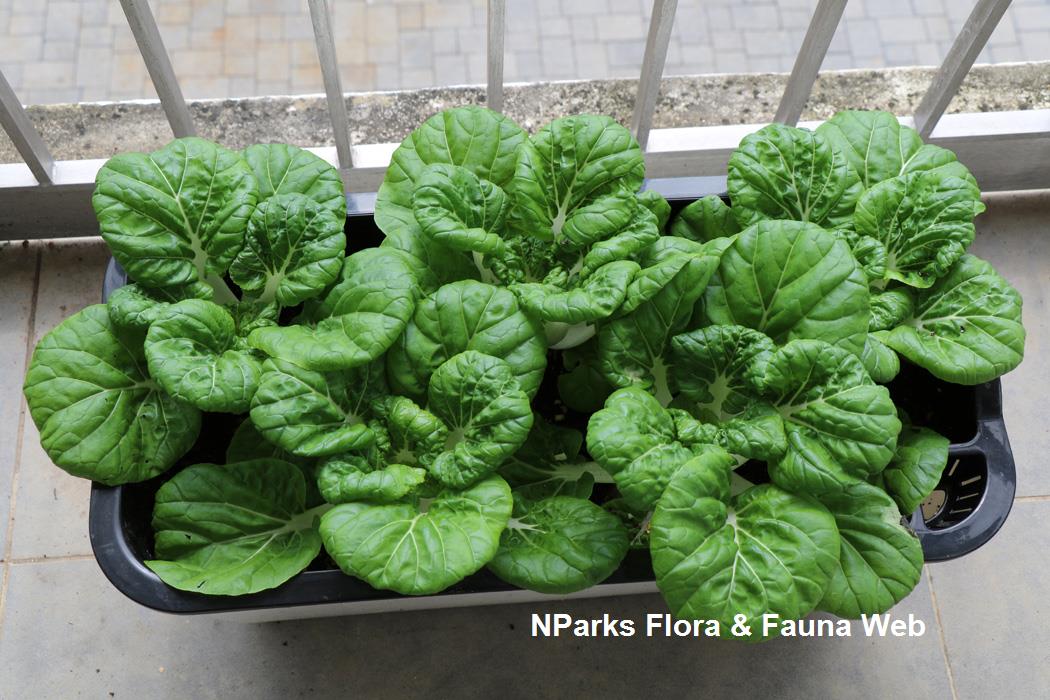
Back
Brassica oleracea Acephala Group [ornamental cabbage]
| Family Name: | Brassicaceae (Cruciferae) |
| Common Name: | Ornamental Cabbage, Flowering Cabbage, 卷心菜 |
Name
Classifications and Characteristics
| Plant Division | Angiosperms (Flowering Seed Plants) (Dicotyledon) |
|---|---|
| Plant Growth Form | Herbaceous Plant |
| Lifespan (in Singapore) | Annual |
| Mode of Nutrition | Autotrophic |
| Plant Shape | Rounded |
Biogeography
| Native Distribution | Western Europe |
|---|---|
| Native Habitat | Terrestrial |
| Preferred Climate Zone | Temperate |
| Local Conservation Status | Non-native (Horticultural / Cultivated Only) |
Description and Ethnobotany
| Growth Form | A biennial which is usually grown as annual, does not not form dense heads like cabbage. |
|---|---|
| Foliage | Leaves are fringed or have wavy margin. |
| Flowers | Cabbage produces flowers following prolonged exposure to cold. The yellow, 4-petalled flowers are arranged along a spike-like inflorescence known as a raceme. |
| Fruit | The fruit is a dry, dehiscent pod known as a silique. |
| Cultivation | Cabbage is a cool season crop, so it is not well-adapted to Singapore's climate and does not grow well when temperatures are consistently above 27 degrees Celsius. However, it is locally available in some nurseries that import plants from cooler climates. Cabbage is best grown under full sun in temperate countries, but needs semi-shade and protection from hot afternoon sun in Singapore. Plant in fertile, well-drained soil, apply mulch around the plant, keep the soil moist and practice crop rotation. |
| Etymology | The genus Brassica is Pliny's name for cabbage-like plants. The specific epithet oleracea refers to cultivation of aromatic / esculent / vegetables. The var. capitata means growing in a head, or head-like. |
| Ethnobotanical Uses | Edible Plant Parts : Edible Leaves |
Landscaping Features
| Landscaping | These cabbages are good as edibles as well as for ornamental on a flowerbed. They are suitable for container planting due to their interesting colour features. |
|---|---|
| Desirable Plant Features | Ornamental Foliage |
| Landscape Uses | Flowerbed / Border, Container Planting |
Plant Care and Propagation
| Light Preference | Semi-Shade |
|---|---|
| Water Preference | Moderate Water |
| Plant Growth Rate | Slow |
| Rootzone Tolerance | Well-Drained Soils, Fertile Loamy Soils |
| Propagation Method | Seed |
| Seed / Spore Germination Duration | 3 days to 5 days |
Foliar
| Foliage Retention | Evergreen |
|---|---|
| Mature Foliage Colour(s) | Pink, Purple, Red |
| Mature Foliage Texture(s) | Crinkled / Twisted |
| Prominent Young Flush Colour(s) | Pink, Purple, Red |
| Foliar Type | Simple / Unifoliate |
| Foliar Shape(s) | Non-Palm Foliage |
| Foliar Venation | Pinnate / Net |
| Foliar Margin | Entire - Wavy / Undulate |
Floral (Angiosperm)
| Flower Colour(s) | Yellow / Golden |
|---|---|
| Flower Texture(s) | Smooth |
| Flower Grouping | Cluster / Inflorescence |
| Flower Location | Terminal |
| Flower Symmetry | Radial |
| Individual Flower Shape | Cruciform / Cross-shaped |
| Inflorescence Type | Raceme |
Fruit, Seed and Spore
| Fruit Classification | Simple Fruit |
|---|---|
| Fruit Type | Dehiscent Dry Fruit |
Image Repository
Others
| Master ID | 30579 |
|---|---|
| Species ID | 4888 |
| Flora Disclaimer | The information in this website has been compiled from reliable sources, such as reference works on medicinal plants. It is not a substitute for medical advice or treatment and NParks does not purport to provide any medical advice. Readers should always consult his/her physician before using or consuming a plant for medicinal purposes. |








